
The Solar-Terrestrial Centre of Excellence (STCE) is a collaborative network of the Belgian Institute for Space Aeronomy, the Royal Observatory of Belgium and the Royal Meteorological Institute of Belgium.
 |
Published by the STCE - this issue : 5 Sep 2014. The Solar-Terrestrial Centre of Excellence (STCE) is a collaborative network of the Belgian Institute for Space Aeronomy, the Royal Observatory of Belgium and the Royal Meteorological Institute of Belgium. |
| Archive of the newsletters | Subscribe to this newsletter by mail |
This movie at http://youtu.be/-j32GM5-LAs shows the development of a magnetic delta near the initially simple sunspot group NOAA 2146, starting on 23 August. One can indeed see how a white patch (positive polarity, field lines coming out of the solar surface) gradually shaped itself south of the main spot (black, negative polarity). Then, late on 24 August, the penumbra of both spots merged and gave NOAA 2146 a delta configuration.
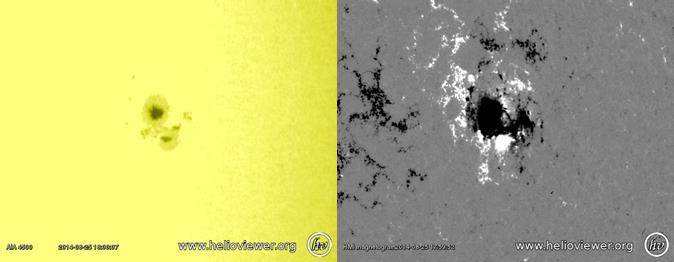
Magnetic delta's are prone to strong flares, so it was no surprize when on 25 August, this sunspot group produced 2 M-class solar flares along the magnetic inversion line, i.e the line separating the areas of opposite polarity. This is shown in the zoom, where extreme ultraviolet (EUV) images from SDO (AIA 171) are overlaid on the magnetogram.
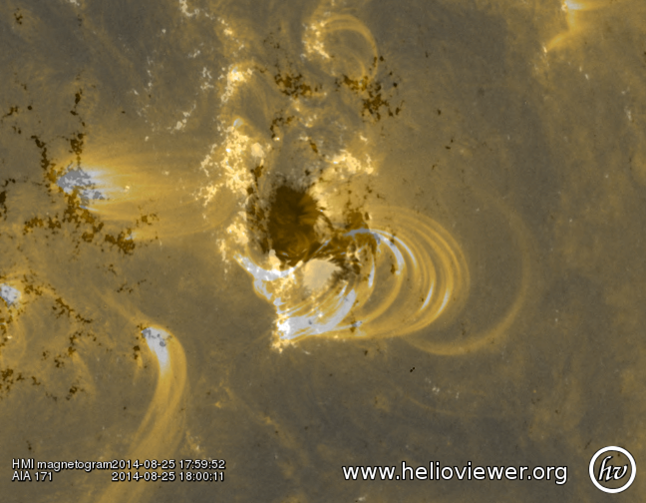
The first M-class flare was an M2.0 peaking at 15:11UT, and the second was an M3.9 peaking at 20:21UT, meaning there were hardly 5 hours between the two events. The movie at http://youtu.be/-j32GM5-LAs shows the phenomena in EUV imagery of successively higher temperatures (AIA 304, 171 and 193 filters, or resp. about 80.000 degrees, 700.000 degrees and 1.3 million degrees). Both flares were associated to coronal dimmings and showed post-flare coronal loops. The image underneath compares the region near NOAA 2146 about one hour before and 1 hour after the peak of the M2.0 flare. The coronal dimming is clearly visible to the west (right) and south of the flaring area, and indicative of a coronal mass ejection.

The EUV combination movie at the end shows how the canopy of coronal loops -still expanding after the first M-flare- apparently got torn apart by the expanding flux rope (twisted bundle of magnetic fields) associated to the second event. It seems that this flux rope was at least only partially ejected during the first reconnection event (see EUV-imagery underneath). An alternative explanation might be that the erupting flux rope actually pushed aside one part of the overarching loops and took with it the remaining part of the coronal loops. This will require some further study. All this activity happened before the M3.9 flare reached its peak (2 minutes after the last image). Then, new post-flare coronal loops got formed as the reconnection moved further upwards in the corona.
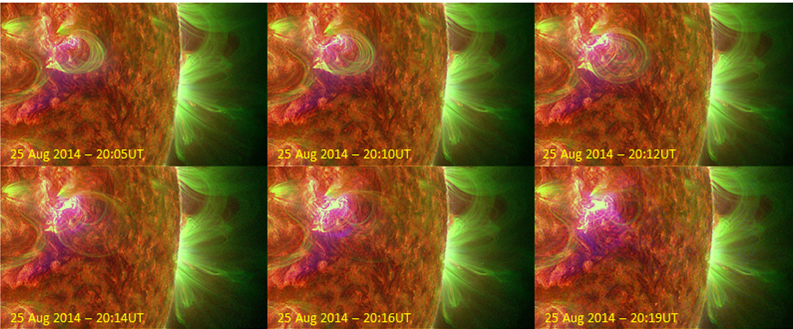
Credits - Imagery was taken from SDO (http://sdo.gsfc.nasa.gov/data/aiahmi/) and (J)Helioviewer (http://helioviewer.org/#).
If you know somebody that works in the field of Space Weather and that person achieved some successes, maybe you can designate that person for a medal.

Check before September 14
http://www.stce.be/esww11/medals.php
The Journal of Space Weather and Space Climate (SWSC, http://www.swsc-journal.org/) welcomes submissions to a topical issue on Statistical Challenges in Solar Information Processing, to appear in 2015. This interdisciplinary issue is an outcome of the 7th Solar Information Processing workshop (http://www.stce.be/sipworkshop2014), which addressed the multiple data analysis challenges of solar and heliospheric missions, and brought together solar and space scientists, statisticians, and data processing experts. The focus will be on how statistical inference and information processing can help addressing research issues in solar/heliospheric science, and provide methodologies.
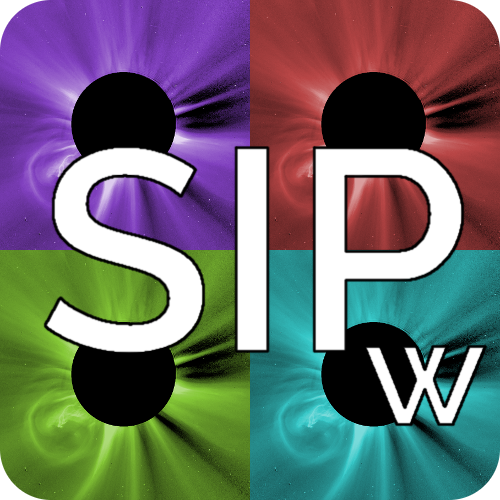
Authors of oral and poster presentations given at the workshop are hereby encouraged to submit manuscripts. However, this topical issue is open to all contributors, and is not limited to workshop participants.
We are presently investigating the possibility to collect in a textbook all articles that are submitted and accepted on time, as it was done for past editions of Topical Issues related to Solar Information Processing workshops.
This topical issue will address, among others:
* Optimal combination of in situ and imaging data
* Tracking of small-scale magnetic features
* Prediction of solar eruptions and solar disturbances
* Characterisation of the solar wind turbulence
* Methodological issues such as Bayesian inference.
* Challenges in present and future instrumentation
22 September 2014: declarations of intent, with preliminary title and list of authors should be sent by email to Thierry Dudok de Wit (ddwit@cnrs-orleans.fr)
15 December: final submission, directly to SWSC, via its online submission tool. Note that the publication fee, which is presently 300 €, will increase as of Jan. 1st, 2015.
All manuscripts will be peer reviewed according to the quality standards of international scientific journals. The type of contributions must fit the style of SWSC. All manuscripts should contain enough new insight, present the results against a properly referenced background of existing work, and present adequate evidence that supports the conclusions. We also welcome articles on statistical methods with a potential to improve data analysis beyond current practices. Accepted papers are published in electronic format only, and are freely available via the internet . SWSC offers the possibility to include electronic material, such as animations, codes, and data.
The guest editors for this topical issue are
* Craig DeForest (deforest@boulder.swri.edu)
* Thierry Dudok de Wit (ddwit@cnrs-orleans.fr)
* Véronique Delouille (v.delouille@oma.be)
* Jack Ireland (Jack.Ireland@nasa.gov)
* Alex Young (c.alex.young@gsfc.nasa.gov)
For questions regarding this topical issue, please contact any of the guest editors. For questions dealing with the submission process, the Editorial Office (swsc@edpsciences.org) should be contacted.
Solar activity was low to moderate during the past week with a total of 38 C-class flares and 2 M-class flares. NOAA AR 2146 and 2149 were the main responsible source regions. NOAA AR 2146 produced an M2.0 flare, peaking on August 25 at 15:11 UT, and an M3.9 flare, peaking on August 25 at 20:21 UT. The other flares originated from NOAA AR 2148, AR 2150, AR 2151 and mainly AR 2152.
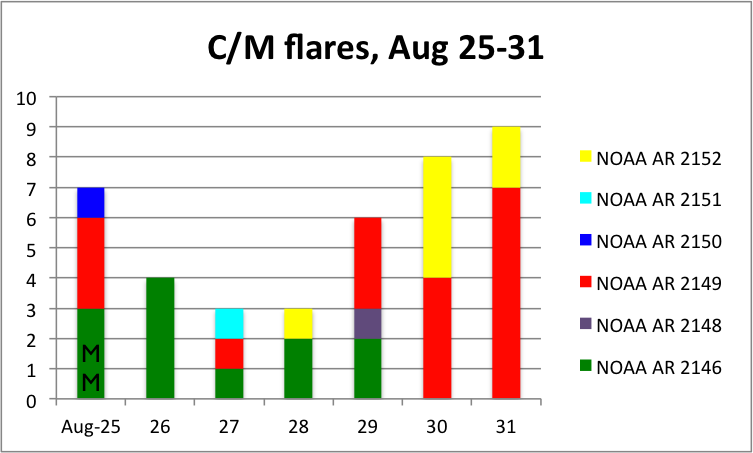
Both M-class flares were associated with CMEs propagating in the western direction from the Sun-Earth line. Conditions were favourable for the two CME's to interact with each other.
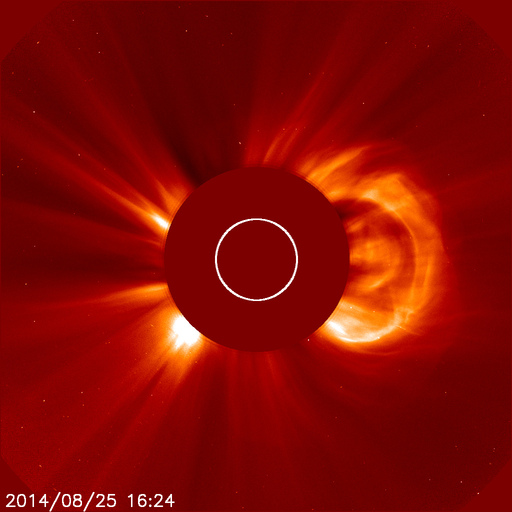
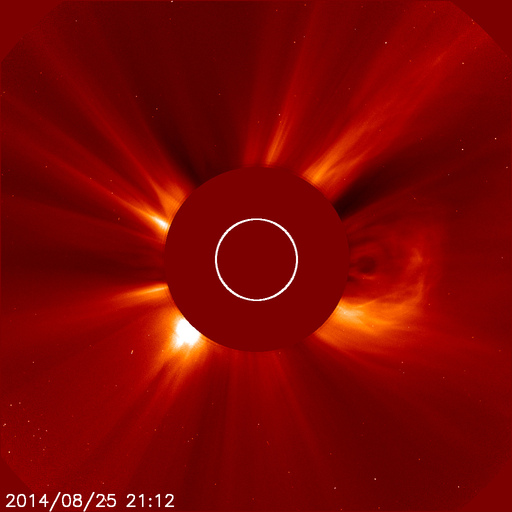
Both pictures are taken by the coronagraph SOHO/LASCO and shows the CME associated with the first (top) and second (bottom) M-flare.
| DAY | BEGIN | MAX | END | LOC | XRAY | OP | 10CM | TYPE | Cat | NOAA |
| 25 | 1446 | 1511 | 1531 | M2.0 | B | 150 | I/1I/2 7V/1 | 2146 | ||
| 25 | 2006 | 2021 | 2029 | M3.9 | 82 | I/2 | 2146 |
| LOC: approximate heliographic location | TYPE: radio burst type |
| XRAY: X-ray flare class | Cat: Catania sunspot group number |
| OP: optical flare class | NOAA: NOAA active region number |
| 10CM: peak 10 cm radio flux |
Solar wind observations of ACE indicated the passage of a magnetic cloud on August 27 which can be probably traced back to two consecutive C6 flares on August 22, one peaking at 12:27UT and one peaking at 15:52 UT both associated with partial halo CME's with very similar coronagraphic appearance.
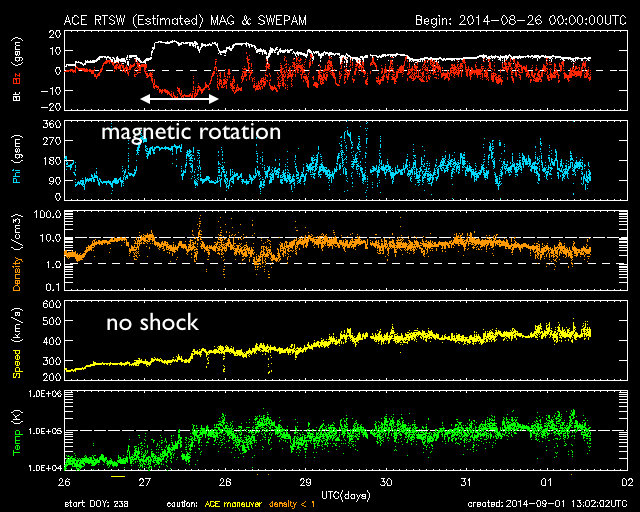
The first signs of a magnetic structure were detected around 0:00 UT on August 27. There was no shock preceding the magnetic structure: the density (orange) nor the solar wind speed (yellow) did not jump suddenly to a higher or lower value. No problem, we can live without shocks.
Although, the data show clearly a magnetic rotation: Bz (red) evolves from zero to a strong negative value back to zero. It means that the magnetic flux rope is oriented vertical such that the magnetic field at the border of the tube that passes first ACE is oriented along the plane perpendicular to the z-axis. When the tube moves further, the Bz-component grows negative and is maximum near the center of the tube. Then Bz becomes again zero telling us that the magnetic field is oriented along the plane perpendicular to the z-axis but now in the opposite direction compared with the front side of the tube. If these sentences are too much to understand at once, reread them with the cartoon below in mind. The flux rope cartoon is taken from an article 'Magnetic stress in solar system plasmas' , Aust. J. Phys, 52, 1999 by C.T. Russel. The ecliptic plane is reduced to a line since the cartoon presents a side view of the system. The flux rope moves to the right and passes at some point ACE.
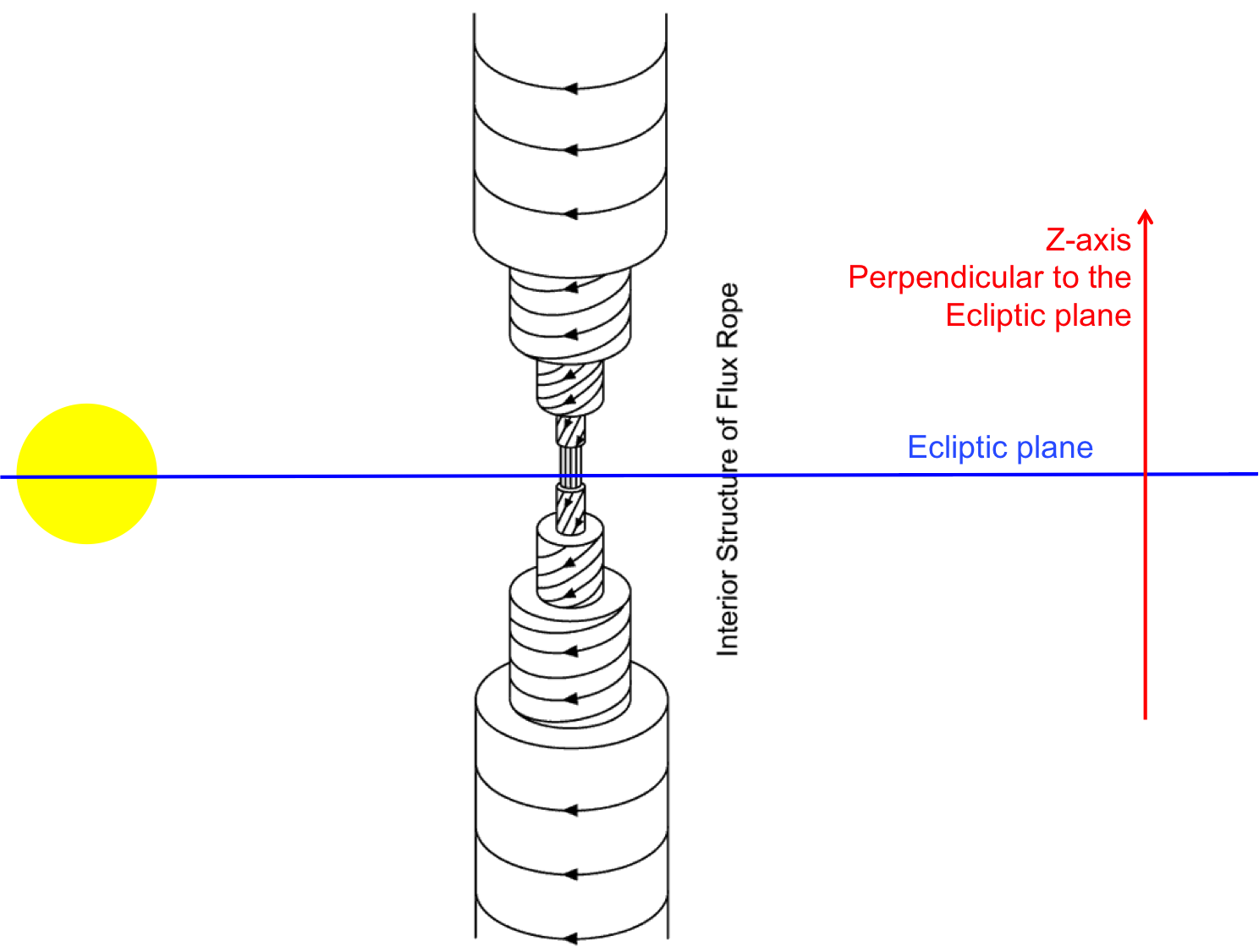
There is however 1 particularity: you expect the temperature to drop while passing a magnetic cloud. This is not really the case. But again, no problem. The magnetic rotation is clear enough to determine the 'thing' as a magnetic cloud.
The solar wind speed (yellow in the ACE graph) smoothly increased from 280 km/s to 420 km/s on August 29 and was relatively stable around 420 km/s for the remainder of the week. The magnitude of the interplanetary magnetic field (IMF) increased from 5 nT to 14 nT, with a mainly negative southward component on August 27. From August 28 on, the magnitude of the IMF declined and remained around 5 nT, while Bz was fluctuating from -9 nT to +5 nT.
The increase in solar wind speed was also related to a coronal hole that crossed the central meridian on August 27. No signature of arrival of the August 25 CMEs was identified in the solar wind observations.
The geomagnetic conditions went through a few short episodes of minor to major storm levels, as indicated by NOAA Kp (Kp=6 and 5 for two separate 3 hour interval late August 28 and 29). The local K at Dourbes only went to K=4.
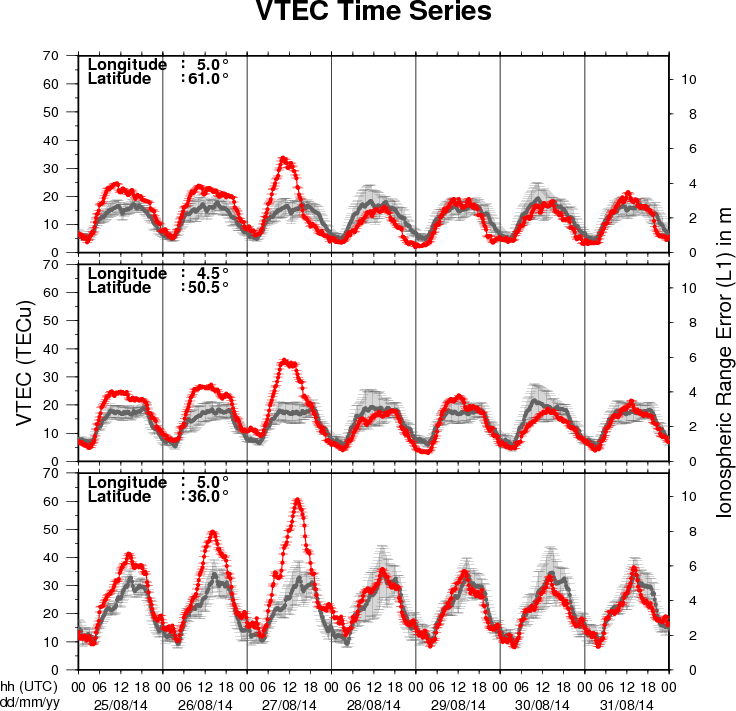
The figure shows the time evolution of the Vertical Total Electron Content (VTEC) (in red) during the last week at three locations:
a) in the northern part of Europe(N61°, 5°E)
b) above Brussels(N50.5°, 4.5°E)
c) in the southern part of Europe(N36°, 5°E)
This figure also shows (in grey) the normal ionospheric behaviour expected based on the median VTEC from the 15 previous days.
The VTEC is expressed in TECu (with TECu=10^16 electrons per square meter) and is directly related to the signal propagation delay due to the ionosphere (in figure: delay on GPS L1 frequency).
The Sun's radiation ionizes the Earth's upper atmosphere, the ionosphere, located from about 60km to 1000km above the Earth's surface.The ionization process in the ionosphere produces ions and free electrons. These electrons perturb the propagation of the GNSS (Global Navigation Satellite System) signals by inducing a so-called ionospheric delay.
See http://stce.be/newsletter/GNSS_final.pdf for some more explanations ; for detailed information, see http://gnss.be/ionosphere_tutorial.php
Start : 2014-09-07 - End : 2014-09-12
Planetary space weather can be characterised by changes in the
ambient planetary magnetic field and plasma populations around the
planetary environment while space climate refers to the long-term
changes in space weather conditions. Space weather and space
climate are driven by the changes in the Sun. The effects of Space
Weather on the Earth's environment are well documented,
particularly in terms of risk to satellites, communications and
ground-based systems such as electrical power grids and pipelines.
However, planetary space weather and space climate studies as well
as better prediction models for space weather are needed. Typically
differences in the magnetic field and plasma environment at
different planets, as well as the distance of the planet from the
sun drives different space weather effects as we move through the
solar system. The use of solar wind propagation models combined
with solar observations allows us to obtain and predict the
interplanetary conditions around each planet.
We solicit papers on planetary as well as terrestrial space
weather and space climate, where data from past and on-going space
missions such as ACE, SOHO, SDO, MEX, VEX, MESSENGER and CASSINI is
used. We welcome papers on observations as well as modeling of
space weather and space climate in our solar system.
Website:
http://meetingorganizer.copernicus.org/EPSC2014/session/16809
Start : 2014-09-09 - End : 2014-09-11
The Workshop on Radiation Monitoring for the International Space
Station (WRMISS) has been held annually since 1996. The major
purpose of WRMISS is to provide a forum for discussion of technical
issues concerning radiation dosimetry aboard the International
Space Station and other spacecraft. This includes discussion of new
results, improved instrumentation, detector calibration, and
radiation environment and transport models. The goal of WRMISS is
to enhance international efforts to provide the best information on
the space radiation environment in low-Earth orbit and on the
exposure of astronauts and cosmonauts in order to optimize the
radiation safety of space crew.
Website:
http://www.ifj.edu.pl/conf/wrmiss/
Start : 2014-09-15 - End : 2014-09-20
The 'Geospace Revisited' conference aims at revisiting
long-standing issues of geospace dynamic phenomena. New data from
space missions like Cluster, THEMIS and the more recent Van Allen
Probes, along with measurements from ground-based magnetometer
arrays around the globe, processed with new methods and combined
with theory and simulations are expected to shed light on the
complex interplay of particles, fields and waves in geospace, and
in particular the inner magnetosphere (radiation belts and ring
current).
Website:
http://geospacerev.space.noa.gr/index.php
Start : 2014-11-12
This conference aims to bring together researchers, engineers,
users in the area of Big Data in the Space sector.
The focus is on the whole data lifecycle, ranging from data
acquisition by spaceborne and ground-based sensors to data
management, analysis and exploitation in the domains of Earth
Observation, Space Science, Space Engineering, Space Weather,
etc.
Special emphasis will be put on highlighting synergies and
cross-fertilization opportunities from domains like Climate Change,
Solid Earth Science, Planetary Sciences, Life Science,
Astrophysics, High Energy Physics, Social Sciences, etc.
We expect this conference to:
* contribute towards a common "Big Data from Space" scientific
and programmatic framework
* widen competences and expertise of universities, labs and
industrial actors
* foster networking of experts and users towards better access
and sharing of data, tools and resources
* leverage innovation, spin-in, spin off of technologies, and
business development arising from research and industry
progress
Website:
http://congrexprojects.com/2014-events/BigDatafromSpace/objectives
Start : 2014-11-17 - End : 2014-11-21
The 11th Edition of the European Space Weather Week will take
place on 17-21nd November 2014 in Liège, Belgium.
The ESWW will again adopt the central aim of bringing together
the diverse groups in Europe working on different aspects of Space
Weather. This includes but isn't limited to the scientific
community, the engineering community, applications developers,
service providers and service end users.
The meeting organisation is coordinated by the Belgian
Solar-Terrestrial Centre of Excellence (STCE), ESA and the Space
Weather Working Team. The local organisation is done by the
STCE.
Website:
http://www.stce.be/esww11/
Start : 2014-12-15 - End : 2014-12-19
The AGU Fall Meeting is the largest worldwide conference in the
geophysical sciences, attracting more than 22,000 Earth and space
scientists, educators, students, and other leaders. For 46 years,
energized and passionate Earth and space scientists from around the
world gather at the AGU Fall Meeting to connect with colleagues,
broaden their knowledge base, and embrace the joy of science. The
2014 meeting takes place Monday 15 - Friday 19 December 2014.
Several sessions about space weather are foreseen:
*
When and Why Does Space weather Forecasting Fail?
*
Addressing Operational Space Weather Needs
*
Near Real Time Data for Earth Science and Space Weather
Applications
*
Understanding Hemispheric Asymmetry and Space Weather
*
Connection of Solar Events With the Variability of Space
Environments
*
Bz from the Sun to the Earth: Observations and Modeling
*
Solar Sources and Heliospheric Consequences of Coronal Mass
Ejections in Solar Cycle 24
*
Advances in Ionospheric Forecasting - Modeling, Observations, and
Validation
Abstract Submission Deadline: August 6, 2014
Website:
http://fallmeeting.agu.org/2014/
Start : 2015-04-20 - End : 2015-04-24
This gathering was born out of the desire to collect in one
place the latest technologies required for advancement of science
in the discipline of Solar and Space Physics. In doing so, it was
recognized that the two 1998 volumes of 'Measurement Techniques in
Space Plasmas' (Particles and Fields) have been a valuable
reference and resource for advanced students and scientists who
wish to know the fundamentals of measurement techniques and
technology.
Website:
https://mtssp.msfc.nasa.gov/
Start : 2015-06-22 - End : 2015-07-02
We invite contributions on novel inversion methods with
application across the geosciences. Of particular interest are 3D
imaging, joint inversion of geodetic, geophysical and geochemical
datasets, and multi-disciplinary interpretation approaches such as
integration of gravity, EM and seismic data or thermo-mechanical
modelling studies constrained by physical parameters.
Modelling of Space Weather Effects: Solar, Magnetospheric and
Earth Resistivity Constraints (IAGA, IAMAS)
In this symposium we welcome contributions on all aspects of the
modelling of space weather and its effects, from the Sun to Earth.
This includes the modelling of the various interactions between
travelling solar storms and the solar wind, magnetosphere,
ionosphere and solid Earth and the validation of models through
measurements. Contributions on models developed to aid end-users,
such as satellite and power grid operators, survive the impact of
space weather are also encouraged.
Website:
http://www.iugg2015prague.com/joint-inter-association-symposia.htm#JA
Presentation given during a users' visit about the STCE operational space weather services and products.
http://www.spaceweather.eu/en/repository/show?id=534
Presentation given during a users' visit about the STCE operational space weather services and products.
http://www.spaceweather.eu/en/repository/show?id=535
Presentation given during a users' visit about the STCE operational space weather services and products.
http://www.spaceweather.eu/en/repository/show?id=536
Presentation given during a users' visit about the STCE operational space weather services and products.
http://www.spaceweather.eu/en/repository/show?id=537
Presentation given during a users' visit about the STCE operational space weather services and products.
http://www.spaceweather.eu/en/repository/show?id=538
Presentation given during a users' visit about the STCE operational space weather services and products.
http://www.spaceweather.eu/en/repository/show?id=539
Presentation given during a users' visit about the STCE operational space weather services and products.
http://www.spaceweather.eu/en/repository/show?id=540
http://www.spaceweather.eu/en/repository/show?id=541